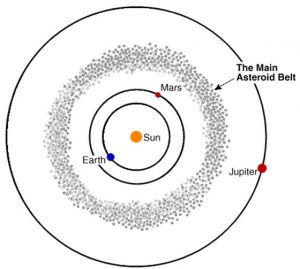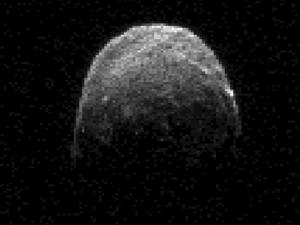We’ve been to the Moon and we’ve explored the planets and asteroids, but some have plans to do far more than simply visit these distant places. While previous expeditions have almost all been in the name of science, there’s now another incentive for private companies to return. The asteroids, in particular, could become an invaluable source for precious metals and minerals that are becoming rare on Earth. So why, where, and how, would we mine the asteroids?
Why Mine the Asteroids?
Our consumption from the Earth’s natural sources of some of these metals – for example, tin, lead, silver, gold, and copper – is now so great that it’s thought the Earth’s supplies could be depleted before the end of the century. Besides cutting down on production or developing artificial alternatives, what other solutions are available?
For that, we must turn our attention to the stars and to the nearby worlds within our own solar system.
Perhaps surprisingly, the Moon’s crust is 60% oxygen (more than the Earth), with silicon, aluminum, calcium, magnesium, iron, and titanium accounting for the vast majority of the rest. While these elements are useful, they’re not predicted to be in short supply any time soon and the Moon lacks the other materials we need.

The Asteroid Belt range in size from around half a mile across to about 600 miles in diameter, and were created at the birth of the Solar System, 4.6 billion years ago. To put it into perspective, the total mass of all known asteroids, more than half a million in all, is about 4% that of the moon. Due to the gravitational influence of Jupiter, some have orbits that carry them close to Earth, in which case they are called Near-Earth Objects, or Near-Earth Asteroids.
And because the asteroids are much smaller than the moon the lower gravitational force will mean that landing and taking off will be less of a problem. Unlike the Earth, heavier metals are distributed evenly throughout an asteroid’s mass rather than closer to the core, and as an added attraction the presence of these materials will often be found in much higher concentrations than on Earth. For instance, it has been estimated that a one-kilometer diameter asteroid could contain about 7,500 tons of platinum, worth more than $195 billion.
By mining the asteroids, we have the opportunity to return those precious metals and minerals to Earth – and potentially the Moon and Mars – for further consumption. As such, their potential value soon becomes clear.
What Are the Asteroids Made Of?
As most people know, the asteroids are primarily rocky in nature, but do they have the minerals and metals we need? In broad terms there are three classifications of asteroids based on their composition:
- C Type

Being the most common type of asteroid, these dark asteroids account for about 75% of all known asteroids.
It’s thought the C-type asteroids are composed of clay and silicate rocks. They primarily orbit the Sun on the outer edge of the asteroid belt and so have been least altered by heat, meaning that they are the most ancient. Due to the fact that some have never even reached temperatures above 50°C, it is estimated they can contain up to 22% water. (Some asteroids might also be extinct comets.) This water could be extracted and used as a propellant, allowing spacecraft to the planets to refuel en-route.
Similarly, iron is a common metal in the asteroids, and while, like water, it’s common on Earth too, mining iron could allow for the construction of machinery and spacecraft within the asteroid belt itself. This could save a lot of time and money as those raw materials would not need to be sent from Earth.
Besides water, C-type asteroids are also high in organic materials that could be used as fertilizer. With future colonies on Mars being required to grow their own food, the asteroids could become an invaluable resource in the human exploration of space.
- S-Types
S-types are the second most common asteroid type and contain numerous varieties of metal. More specifically, nickel and cobalt are in abundant supply while rarer metals, such as gold, platinum, and rhodium can also be mined. They inhabit the inner Asteroid Belt.
- M-Type
The third most populous group of asteroids, the M-type, are known to be high in metals, especially nickel and iron, but are rarer than the other two types. C and S-type asteroids account for about 92% of all asteroids, but M-types only account for roughly 7%. They are found in the middle region of the Asteroid Belt.
How Will the Asteroids by Mined?
Since humans are currently confined to Earth orbit and have yet to return to the Moon or land on Mars, the chances of there being manned expeditions to the asteroids are slim. There are, however, a number of viable alternatives.
The traditional method of mining – digging a shaft into the rock – is one option, but it has a couple of problems associated with it. Firstly, you’d need to know the best location on the asteroid to mine and, secondly, you’d then need to deliver the mined material to a processing facility.
Another idea involves scraping loose material off the surface of the asteroid with a scooper. This could be particularly effective on “rubble pile” asteroids. Essentially large rocks clumped together, this is where the loose surface material is thought to be most abundant.
Similarly, the surfaces of metallic asteroids could be coated with grains of material that could then be collected with a magnet.
Other asteroids contain hydrated minerals and water that could be extracted by heating the asteroid to a high temperature. This works like a comet approaching the Sun; as the comet gets closer, it experiences higher temperatures and dispels frozen liquids as vapor. Likewise, in laboratory tests, water has been extracted from simulated asteroid regolith as water vapor, which could then be condensed into liquid water.
Another heating technique, called the Mond process, could be used on nickel-iron asteroids. By passing carbon monoxide over the heated asteroid, nickel and iron based gasses are released. The nickel and iron can then be removed from the gas, leaving behind the desired minerals.
One other option is self-replicating machines. The concept here is that an automated facility could be built within the asteroid belt. This facility could then build more machinery and other facilities from the raw material mined from the asteroids.
Although this idea still lies within the realm of science fiction, it’s thought it may be feasible within two to four decades and could become a reality when asteroid mining itself begins.
Who Will Mine the Asteroids?
The problem, more than anything, is cost, with many scientists expressing skepticism that mining the asteroids is financially feasible. Some believe that the cost of mining and returning the material to Earth could be more than its value.
There were a number of privately-owned companies that had their eyes on these asteroids. One, Planetary Resources, which had the backing of several billionaires and boasted film director James Cameron as an advisor went defunct in 2018 due to lack of funding after raising $50 million until 2016. Another start-up, Deep Space Industries, which had raised $3.5 million by 2015 went defunct in 2019. The third one, Kepler Energy and Space Engineering (KESE), which started in 2013 is now as good as gone. The space is hard and the mining dreams are almost shattered(for now).
Time, money, and a strong desire to explore may one day provide us the opportunity to take for ourselves the gifts the asteroids have to offer.

Great article, Stephen!
Is there any chance we could harpoon one of these C-type asteroids and reel it in to excavate from closer quarters?
Yes, my imagination is running wild, courtesy of Stephen Shaw…my thanks to the author for this illuminating read!!
Hi Paul,
Thanks for your question. Your imagination has served you well. Your idea of capturing an asteroid is exactly what the scientists at Planetary Resources are hoping to do. These asteroids only briefly come close to the Earth, so if we can grab one and move it into an orbit closer to the Earth, then it would be available for us to mine its resources whenever convenient for us.